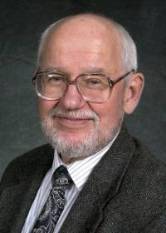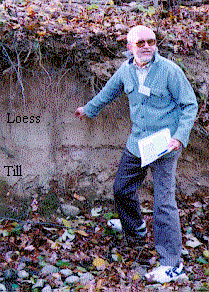 |
Gilbert N. Hanson(1936 - 2023) |
In Memoriam: Gilbert N. Hanson (1936-2023)
Gilbert (Gil) Hanson, one of the founding members of Earth and Space Sciences (now
Geosciences) at Stony Brook University passed away on September 21, 2023. When we
celebrated the 50 th anniversary of our department in 2015, Gil had been here for
all but one of those years. Gil served as the graduate advisor for 6 years (1970-1975;
and 1982-1983) and the chair of our department for 10 years (1983-1993). Gil retired
in 2019. Sadly, COVID prevented us from being able to have a retirement party in the
spring of 2020 to say thank you for all he did, and the amazing legacy he has left.
We are proud of the collegiality of our department and Gil played a pivotal role in
establishing this welcoming environment. As Don Weidner said, ‘Gil was a mentor to
me in the hard times and a great friend in the good ones’.
He is survived by his loving wife, Janet Hanson; siblings E. Katherine Schultz (Donald), Ludmilla Isaacson (Philip), and John J. Hanson (Freya); children, Lynn Hoff (John), Kevin Hanson (Tina), and Darlene Anderson (Edmond); and grandchildren, Bryson and Deanna Hoff, Isabel Tuason and Emma Hanson, and Saimoen, Edmond, and Gia Anderson.
Gil was born and raised in Minnesota and completed all his degrees at the University of Minnesota. For his graduate degrees, he worked with Paul Gast using K/Ar and Rb/Sr to consider the closure temperature of minerals under contact metamorphic conditions (a current hot topic in the field), as well as the effects of weathering on those systems. Following his PhD Gil worked for the Minnesota Geological Survey for one year before heading to the Swiss Federal Institute of Technology in Zurich (ETH), Switzerland as a post-doc. Gil was hired at Stony Brook in 1966, as an Assistant Professor, was promoted to Associate Professor in 1970 and to Full Professor in 1975. He brought a strong connection with Minnesota geology to Stony Brook, and made some significant advances in the Archean and Paleoproterozoic geological history recorded in the plutonic rocks, some with Stony Brook graduate students. He also had long-term collaborations and applied similar approaches to Precambrian terranes in India. Gil was a remarkable geologist and isotope geochemist and he reinvented himself several times through his career. He made significant advances in the application of trace elements and isotopes in igneous rocks, in the mineralogy/ geochemistry and geochronology of metamorphic rocks, in the applications of trace element and isotope geochemistry and geochronology to carbonate and siliciclastic sedimentary rocks as well as in ground waters and local sediments on Long Island. He even studied soils and septic systems along with groundwater to better understand the sources of nitrate to the sole source aquifer of Long Island. And many of these advances were made because of his great capacity for partnering with other professors to guide graduate students to bridge the fields. Gil was named Distinguished Service Professor at Stony Brook in 2000.
Gil worked with a remarkable number of graduate students, including 30 MS students, 31 PhD students, and 8 post-docs. Gil was the primary advisor of 17 of the 31 PhD students, and he worked with 7 faculty colleagues to mentor the remaining 14 PhD students. Gil’s understanding of trace elements and isotopes and use of inverse modeling allowed him to make substantive contributions to many of the subfields in geology. In the lab his mantra was ‘you as the operator can fix it’. This is a main reason that isotope labs around the world are populated by Gil’s students. Gil was a fellow the American Geophysical Union, the European Association of Geochemistry, the Geochemical Society, the Geological Society of America and the Geological Society of India. He served in leadership capacities on numerous AGU committees including being the president of the Volcanology Geochemistry and Petrology (VGP) section. But he never talked about these things. Instead, he talked about the students he had worked with and admired their successes.
As summarized by Martin Schoonen, Gil was the driving force in organizing local geologists and conducting research on Long Island. This really got started after he came back from a review of the Geology Department at the University of Minnesota. During the review, one of the reviewers asked if anybody in the community cared whether there was a geosciences department at U. Minnesota. At the next faculty meeting at Stony Brook, he pointed out that it would be important to develop a community connection. In rapid succession, he started "Long Island Geologists"; and put on an annual conference and field trips. The Long Island Association Professional Geologists (LIAPG) developed from this and the founders of this group worked with Gil to establish licensing for geologists in New York state. This group has several dinner meetings a year with a talk, and their members sponsor students from Stony Brook giving them an opportunity to meet potential employers. The 30th LIG conference was held in April 2023 and many of us had the opportunity to share Gil stories and thank him for his contributions and friendship. We are proud of this tradition and Long Island Geologists meetings will continue! We also plan to bring back field trips- an activity in which Gil was always an enthusiastic and exceedingly energetic leader, frequently exhausting people a fraction of his age. At the same time Gil also established Geology Open Night, inviting the community to come see what we do with a faculty member giving talks on the last Friday of each month during the academic year.
In the final chapter as a professor, as he thought about retirement, he considered all of the things that he wanted to do and realized he wanted to be a professor. He poured his energy into teaching, particularly working with teachers. He frequently said ‘would you want a piano teacher who read about it, or would you want a piano teacher that was a pianist?’ He felt strongly that teachers needed a hands-on experience in the field and in the lab. He took on the role as the Masters of Arts and Teaching (MAT) advisor and worked closely with the School of Professional Development (SPD) to establish a program which would allow teachers to get a bachelors and masters degree in 5 years while enhancing, rather than watering down, the level of the training. In the process, he elevated the quality of Stony Brook’s earth science teacher program to the point where it has produced a broad cadre of the region’s top teachers, including a disproportionate number awarded the title of ‘master teacher’. He also established a number of courses to provide the kind of hands-on experience that is so essential in the earth sciences, including Field Methods, Glacial Geology, and Geomorphology. He worked with faculty to establish night courses and weekend short courses for teachers with content they needed to be successful teachers and which focused on that hands-on experience.
In 2007 Gil received funding from NSF for Track 1 GeoPrep: Building a Geoscience Pathway for High Need Long Island High Schools. This funding brought numerous students to Stony Brook to participate in summer research in our labs. Local teachers were employed to oversee the day-to-day activities of the students, building on the strong foundation he had established with these teachers in the MAT program. This was followed by a GeoPREP Track 2: Expanding the Geoscience Pathway which continued to bring high school students from underserved schools to Stony Brook for a paid research experience. The work was further extended with Brian Colle of the School of Marine and Atmospheric Sciences at Stony Brook (SoMAS) as the lead PI and Gil as co-PI with an NSF grant GP-IMPACT: Increasing Geosciences Enrollment through Research Experiences, Mentoring, and Curriculum Interactions with Community Colleges and High Schools which brought students from Suffolk County Community College to Stony Brook for a lab experience. A number of these students transferred to Stony Brook and we currently have 4 of them enrolled in our PhD program.
Gil was a character. He was famous for his quotes such as ‘walking is a mode of transportation’ and ‘geology starts as soon as you go out the door’. He was described in the numerous notes we got from former students as an amazingly kind person. Gil was pivotal in shaping the direction of the department and developing the collegial culture within the department. Gil was very generous with his time and he helped all of us in one way or another. This soft spoken, gentle soul was a loving, kind, understanding, and supportive father, husband, grandfather, brother, teacher and friend. We lost a great colleague and firend.
 Gil pointing to loess above till
Gil pointing to loess above till
on the Stony Brook Campus
